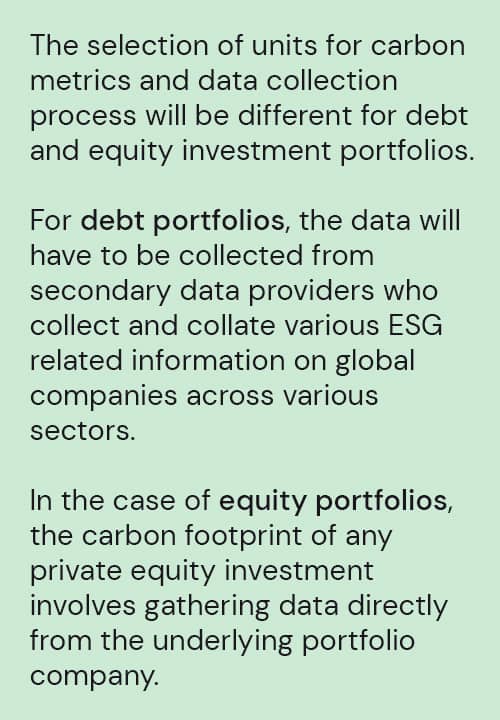Role of Financial Institutions in Achieving Net-Zero
2020 was a significant year where commitments around “net-zero targets” gathered momentum. Announcements were made across the board, from national governments to industries and sectors to achieve net-zero carbon emissions by a specific date. The Paris Agreement has established a timeline to 2050 to achieve this, with concrete interim targets to be set for 2030 and 2040.
Achieving net-zero in just three decades is an enormous challenge. Financial Institutions (FIs) will have a critical role to play through the capital they control. Therefore, it is imperative that FIs understand their portfolio emissions and strategize to decarbonize their investment portfolios. Currently, only a handful of firms have begun quantifying their portfolio emissions and are working towards carbon neutral portfolios by 2050. While the prospect of undertaking such an exercise can seem daunting, FI’s can start by conducting a pilot assessment of the carbon footprint of their portfolios using information that is already accessible.
Setting the Context: Importance of Assessing the Carbon Footprint of an Investment Portfolio
When considering this fundamental shift in investment behavior, the first step is to obtain decision-useful information such as the carbon footprint of a portfolio. As the saying goes, what can be measured, can be managed. Therefore this footprinting exercise can aid in effectively monitoring an FI’s progress towards both setting and achieving its interim and final net-zero targets across portfolios. For example, FIs can track changes in the volume of the emissions financed across sectors and choose to position portfolios to prioritize low carbon investments.
Due to the large number of investment instruments available across multiple asset classes, the overall process of quantifying the carbon footprint of a portfolio can seem complex. The methodologies will differ based on the type of portfolio and each asset class, requiring an extensive volume of information to be collected. For FIs looking to initiate the quantification process successfully for the first time, it would be prudent to begin with a pilot assessment. The key is to initiate the carbon quantification process with information that is readily accessible.
Getting Started: Using Readily Available Information to Conduct a Pilot Assessment
Access to the right resources can help simplify the carbon footprinting process. In fact, organizations often and unknowingly monitor several data points that may be relevant to the quantification process. If actual data is not available, the initial carbon assessment can be based on estimations and proxies. FI’s can consider conducting a pilot carbon assessment of a select portfolio to test the readiness and maturity level in this regard.
We have highlighted the top three considerations to help FIs begin the process.
1. Understand and evaluate different types of carbon metrics that can be used
Even though quantifying the carbon footprint of a portfolio is a relatively new trend, there are several metrics that are being used in this assessment process. Each carbon metric has its own set of advantages and disadvantages and tells the FI something different about the portfolio. FIs can consider selecting metrics that fulfill the ultimate objective of this quantification process. The objectives could be defined internally and at the discretion of the FI, or it could be set by external stakeholders such as investors looking for specific climate-related information.

This is important because FIs may want to compare the performance of several different portfolios or provide disclosure to investors who may want to compare the portfolio emissions reduction performance of different FIs.
2. Assess the quality of data that is readily accessible
Actual data, rather than proxies, used in the carbon footprint calculation will lend credibility and accuracy to the assessment process. If FIs are relying on emission information in their decision-making, the quality of the assessment will be critical. However, access to actual data may not always be possible. In this case, estimations and proxies can be relied upon to calculate the carbon footprint, but should be relevant and aligned to the asset class and sector of investment. If instead, FI’s choose to begin the assessment process with actual data, they need to consider how to collect data and assess the level of effort required.
For example, consider the data collection process for a mortgage portfolio. FIs can either use average, regional energy figures for the initial pilot assessment or collect individual energy purchases from their mortgage customers. Based on the access that the FI has to the mortgage holder and the size of the portfolio, the effort required for the data collection will vary.
3. Refer to available industry standards, frameworks, and guidelines
Resources and tools available to the financial industry are evolving rapidly. Many are developing and enhancing standards, methodologies, and guidelines to help assess, quantify and disclose climate-related information. Depending on the type of FI and nature of the portfolio, different frameworks can be used to guide the carbon footprint assessment process.
For example, the Partnership for Carbon Accounting Financial (PCAF) is emerging as one of the important industry standards for calculating carbon emissions of FIs across different types of asset classes. There is a specific PCAF Standard for North America, one for the EU and another Global Standard that has just been released.
The Task Force on Climate-related Financial Disclosures (TCFD) is currently the leading industry standard for climate-related financial risk disclosures. It includes specific recommendations for financial institutions and includes portfolio metrics. However, the original “Weighted Average Carbon Intensity” metric has not been taken up by the industry. To address this challenge going forward, the TCFD released a consultation paper on “Forward looking Financial Sector Metrics”. Examples of suggested forward-looking metrics include Implied Temperature Rise (ITR) and climate Value-at-Risk (climate VaR).
Additionally, the Institutional Investors Group on Climate Change (IIGCC) has launched a new net-zero investment framework designed to assist investors in their journey to decarbonize their investment portfolio. The Framework also includes a complete set of recommended metrics, and methodologies which FIs can refer to. Five investors are currently testing out the framework across portfolios collectively worth $1.3 trillion.
In case FI’s lack clarity on which carbon metrics to consider for the pilot assessment, Manifest recommends that FIs make use of the carbon metrics previously proposed by TCFD while simultaneously evaluating the merit of using other forward-looking metrics for future carbon footprint assessments.
Key Outcomes of the Pilot Carbon Footprinting Assessment
After the completion of the pilot project, the FI should be able to:
- Understand the FI’s readiness and maturity level in conducting a carbon footprint assessment of a portfolio
- Assess whether the footprinting process generated “decision useful” information
- Identify areas of strength and areas that need improvement. This could also include the Identification of the right carbon portfolio metrics that work for the FI’s portfolio and the subsequent identification of data needs
- Define a plan of action to bridge the gaps identified
- Develop a short, medium and long-term roadmap for improving the quantification methodology with clearly defined milestones
- Understand industry trends in setting emissions reduction targets across investment portfolios and identifying relevant best practices
Looking to the Future: Improving the Robustness of the Carbon Footprint Assessment Methodology
The pilot assessment is just the first step in thinking about how to align the organization’s portfolio towards low carbon investments. The learnings from the initial carbon footprint assessment can act as drivers to improve the quality of the overall methodology used in the long term. FIs could consider refining a methodology that can ultimately:
- Monitor progress made towards meeting the interim (towards 2030 and 2040) and final targets set towards achieving net-zero by 2050
- Improve the transparency and comparability of results emerging from the assessment process
- Use actual data as much as possible
- Be used across different portfolios with multiple asset classes
- Make provision for multiple metrics to be used- especially forward-looking metrics.
- Grow to meet industry standards and generates information as required by investors
Approaching the Carbon Footprint Assessment of an Investment Portfolio as a “Must-Do”
The financial industry is the “hub” that supports other industries and sectors i.e. the “spokes” in their growth and development. If the financial industry makes diligent efforts towards net-zero, this would drive other industries to do so as well. First, however, FIs must understand their own emissions. Thus, quantifying the carbon footprint of an investment portfolio is a “must-do” practice for FIs. A footprint allows setting targets and tracking progress. With everyone working together, we could perhaps achieve the goals and targets outlined by the Paris Agreement and limit global warming to 1.5- 2 degrees Celsius.

